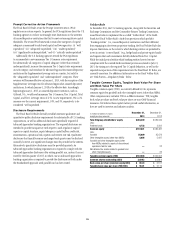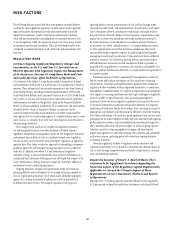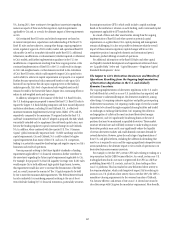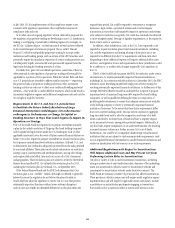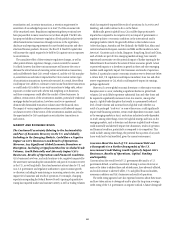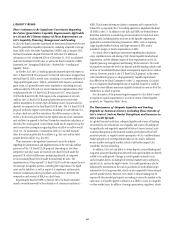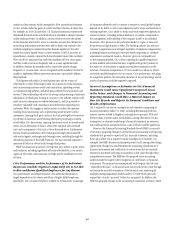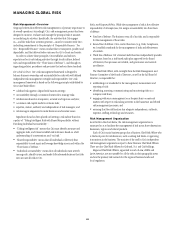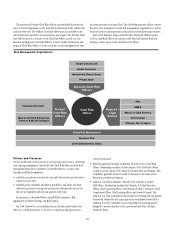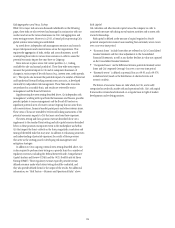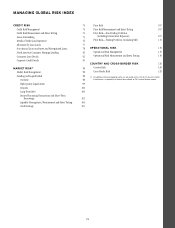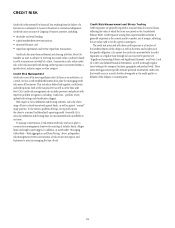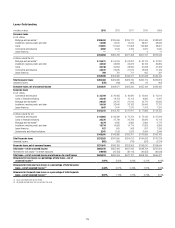Citibank 2013 Annual Report Download - page 83
Download and view the complete annual report
Please find page 83 of the 2013 Citibank annual report below. You can navigate through the pages in the report by either clicking on the pages listed below, or by using the keyword search tool below to find specific information within the annual report.65
parameters of the annual stress testing process may be altered from time to
time, including the severity of the stress test scenario, Federal Reserve Board
modeling of Citi’s balance sheet and the addition of components deemed
important by the Federal Reserve Board (e.g., a counterparty failure). These
parameter alterations are difficult to predict and may limit Citi’s ability
to return capital to shareholders and address perceptions about Citi in the
market. Because it is not clear how the Federal Reserve Board’s proprietary
stress test models and qualitative assessment may differ from the modeling
techniques and capital planning practices employed by Citi, it is likely that
Citi’s stress test results (using its own models, estimation methodologies and
processes) may not be consistent with those disclosed by the Federal Reserve
Board, thus potentially leading to additional confusion and impacts to Citi’s
perception in the market.
Citi’s Ability to Achieve Its 2015 Financial Targets Will
Depend in Part on the Successful Achievement of Its
Execution Priorities.
In March 2013, Citi established certain financial targets for 2015. Citi’s
ability to achieve these targets will depend in part on the successful
achievement of its execution priorities, including: efficient resource
allocation, including disciplined expense management; a continued focus
on the wind-down of Citi Holdings and getting Citi Holdings to “break even”;
and utilization of its DTAs (see below). Citi’s ability to achieve its targets
will also depend on factors it cannot control, such as ongoing regulatory
changes and macroeconomic conditions. While Citi continues to take
actions to achieve its execution priorities, there is no guarantee that Citi will
be successful.
Citi continues to pursue its disciplined expense-management strategy,
including re-engineering, restructuring operations and improving efficiency.
However, there is no guarantee that Citi will be able to reduce its level
of expenses, as a result of announced repositioning actions, efficiency
initiatives, or otherwise. Citi’s expenses also depend, in part, on factors
outside of its control. For example, Citi is subject to extensive legal and
regulatory proceedings and inquiries, and its legal and related costs remain
elevated. Moreover, investments Citi has made in its businesses, or may make
in the future, may not be as productive or effective as Citi expects or at all.
In addition, while Citi has made significant progress in reducing the
assets (including risk-weighted assets) in Citi Holdings, the pace of the
wind-down of the remaining assets has slowed as Citi has disposed of many
of the larger businesses within this segment and the remaining assets largely
consist of legacy U.S. mortgages with an estimated weighted average life
of six years. While Citi’s strategy continues to be to reduce the remaining
assets in Citi Holdings as quickly as practicable in an economically rational
manner, sales of the remaining larger businesses could largely depend on
factors outside of Citi’s control, such as market appetite and buyer funding,
and the remaining assets will largely continue to be subject to ongoing run-
off and opportunistic sales. As a result, Citi Holdings’ remaining assets could
continue to have a negative impact on Citi’s overall results of operations.
Moreover, Citi’s ability to utilize the capital supporting the remaining assets
within Citi Holdings and thus use such capital for more productive purposes,
including return of capital to shareholders, will also depend on the ultimate
pace and level of the wind-down of Citi Holdings.
Citi’s Ability to Utilize Its DTAs, and Thus Reduce
the Negative Impact of the DTAs on Citi’s Regulatory
Capital, Will Be Driven by Its Ability to Generate U.S.
Taxable Income.
At December 31, 2013, Citi’s net DTAs were $52.8 billion, of which
approximately $41.9 billion and $40.6 billion were not included in Citi’s
regulatory capital, due to either disallowance (deduction) or permitted
exclusion, under current regulatory capital guidelines and the Final Basel
III Rules, respectively. In addition, of the net DTAs as of year-end 2013,
approximately $19.6 billion related to foreign tax credits (FTCs). The carry-
forward utilization period for FTCs is 10 years and represents the most time-
sensitive component of Citi’s DTAs. Of the FTCs at year-end, approximately
$4.7 billion expire in 2017, $5.2 billion expire in 2018 and the remaining
$9.7 billion expire over the period of 2019-2023. Citi must utilize any FTCs
generated in the then-current year prior to utilizing any carry-forward
FTCs. For additional information on Citi’s DTAs, including the FTCs, see
“Significant Accounting Policies and Significant Estimates—Income Taxes”
below and Note 9 to the Consolidated Financial Statements.
The accounting treatment for realization of DTAs, including FTCs, is
complex and requires a significant amount of judgment and estimates
regarding future taxable earnings in the jurisdictions in which the DTAs
arise and available tax planning strategies. Citi’s ability to utilize its DTAs,
including the FTC components, and thus use the capital supporting the
DTAs for more productive purposes, will be dependent upon Citi’s ability
to generate U.S. taxable income in the relevant tax carry-forward period,
including its ability to offset any negative impact of Citi Holdings on Citi’s
U.S. taxable income. Failure to realize any portion of the DTAs would also
have a corresponding negative impact on Citi’s net income.
The Value of Citi’s DTAs Could Be Significantly Reduced If
Corporate Tax Rates in the U.S. or Certain State or Foreign
Jurisdictions Decline or as a Result of Other Changes in the
U.S. Corporate Tax System.
Congress and the Obama Administration have discussed decreasing the U.S.
corporate tax rate. Similar discussions have taken place in certain state and
foreign jurisdictions, including recent proposals in the State of New York.
While Citi may benefit in some respects from any decrease in corporate tax
rates, a reduction in the U.S., state or foreign corporate tax rates could result
in a decrease, perhaps significant, in the value of Citi’s DTAs, which would
result in a reduction to Citi’s net income during the period in which the
change is enacted. There have also been recent discussions of more sweeping


